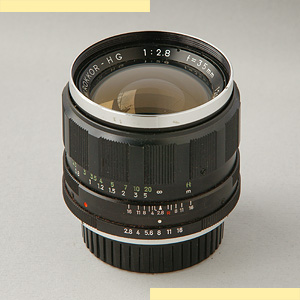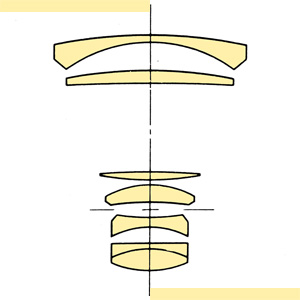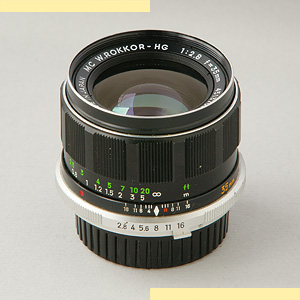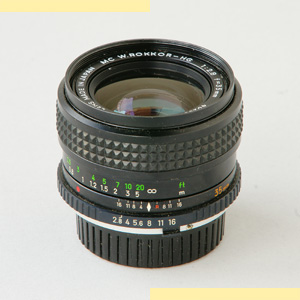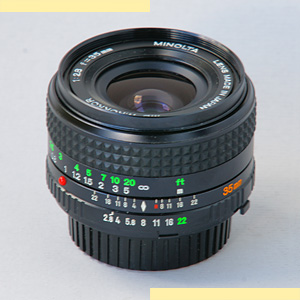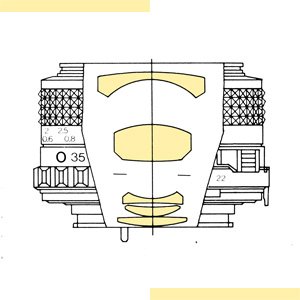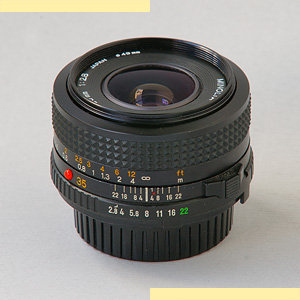Die klassische Brennweiten / Lichtstärke-Kombination von 35 mm und 1:2.8 wurde bei Minolta zusammen mit den ersten Minolta-SLRs (SR-1 und SR-2, 1958/59) eingeführt. Abgesehen von einem obskuren Prototypen, der noch nicht als Retrofokus konstruiert war, sind drei weitere optische Varianten bekannt: Zwei Siebenlinser in sechs Gliedern und ein Fünflinser mit freistehenden Linsen.
Die erste Konstruktion (ab 1959) basiert auf dem klassischen "Retrofocus" von Angénieux, das 1950 als erstes wirkliches Weitwinkel-Objektiv für Spiegelreflex-Kameras vorgsetellt worden war. Die zweite Konstruktion (ab 1965) als klassisches Tessar mit vorgeschaltetem Weitwinkel-Konverter ausgeführt. Die letzte Version von 1975 kann im Prinzip als Ernostar mit vorgelagerter Zerstreuungslinse (=Weitwinkelkonverter) verstanden werden, allerdings ist wirkt die ganze Konstruktion deutlich "integraler" als beim Vorgängermodell. Zumindest der Fünflinser gilt als optisch und mechanisch exzellente Konstruktion. Der Siebenlinser (1965-1975) hingegen ist sehr anfällig auf eine verharzte Blende; praktisch alle heute gehandelten Exemplare haben dieses Problem.
Test an 24MP Vollformat
Test an 16 MP APS-C
Performance of the MC-X [7/6] version on 16 MP APS-C (reproduced with permission from Benjamin Gövert / vintagelensreviews.com):
The lens starts a little soft at f/2.8 with medium haze and mushy corners. Resolution actually isn’t bad. At f/4, the haze clears in the center but still affects the corners. Central sharpness improves to medium to good values. Stopping down to f/5.6 finally clears up the corners which are now passable, while the center reaches close to very good sharpness. Performance becomes even across the image at f/8 with the center being very lightly affected by diffraction. The latter is slightly more pronounced at f/11 and visibly softens f/16.
CAs are not apparent at f/2.8 due to the haze. A slight red and dark cyan glow becomes visible at f/4 and transforms into very small red/cyan CAs at f/5.6. The aberrations stay constant when stopping down. Overall, a very good performance for a wide angle lens.
Vignetting is about 1 a stop at f/2.8, shrinks to 1/3 of a stop at f/4 and is gone by f/5.6. The lens also exhibits a small barrel distortion of -0.3%. The effective T-stop at f/2.8 is T3.2 (-0.4 EV), which isn’t impressive.
The MC 35 mm f/2.8 shows the typical weaknesses of vintage wide angles: Soft corners and uncorrected longitudinal CAs leading to a visible glow at large apertures. But stopped down to f/5.6, it compares favorably to a modern kit lens like the Sony SELP1650. Especially in terms of sharpness and resolution, the MC f/2.8 delivers pretty much the same performance as Sony’s compact zoom, which – to be fair – is already wide open at f/5.6. If you want more, you should look for the MD-II version of the 35 mm f/2.8, or go for the MC W.Rokkor-HH 35 mm f/1.8. The f/1.8 really destroys it’s competitors in terms of sharpness and corner performance, but shows visibly more CAs and is rather large and heavy for a 35 mm.
Performance of the MD-II [5/5] version on 16 MP APS-C (reproduced with permission from Benjamin Gövert / vintagelensreviews.com):
The lens shows acceptable sharpness at f/2.8 with no apparent haze but rather soft corners and some astigmatism (horizontal lines are rendered sharper than vertical ones). At f/4 the center get’s a head start and reaches close to very good sharpness, while the corners are now at least acceptable. They further improve at f/5.6 where the central region shows a very good performance – maybe it even deserves an “excellent”. f/8 is a tiny bit softer again in the center and the corners still don’t impress. Diffraction becomes apparent at f/11, visibly softens f/16 and mushes f/22.
A dark red and cyan glow is visible at f/2.8 which finally sharpens up at f/8 to form some small CAs. The aberrations stay constant when stopping down further. A very good performance for a wide angle lens.
Vignetting is about 2/3 of a stop at f/2.8 and is gone by f/4. The lens also exhibits a small barrel distortion of -0.6%. The effective T-stop at f/2.8 is T2.9 (-0.1 EV), which is very good.
The MD 35 mm f/2.8 is a top performer in every aspect. With the exception of slightly soft corners – probably due to field curvature – it does not show any weaknesses and can be used even wide open without restrictions. Compared to it’s older cousin, the MC W.Rokkor-HG 35 mm f/2.8, the MD is ahead in every aspect. If you want even more, go for the MC W.Rokkor-HH 35 mm f/1.8. The f/1.8 really destroys it’s competitors in terms of sharpness and corner performance, but shows visibly more CAs and is rather large and heavy for a 35 mm.
Hat eigentlich schon mal jemand hier das MC W.Rokkor-HG 2.8/35 und das späte MC W.Rokkor 2.8/35 verglichen? ... Nun, ich wollte wirklich nach dem Unterschied der alten 7/6 Konstruktion (Nummer 70-72 nach Dennis) und der neueren 5/5 Konstruktion (Nummer 74ff) fragen. Anscheinend sind ja die 2.8/35 in der 5/5 Konstruktion dann später nicht mehr geändert worden. Von der Vergütung mal abgesehen. Und da die älteren Objektive ja auch schon mehrfach vergütet sind, bekümmert mich das eigentlich weniger.
ChristophPeterS. (www.mi-fo.de)
Ich hatte eine Zeit lang sowohl ein frühes 35/2.8 MD-W.Rokkor (55mm Filtergewinde) als auch ein spätes 35/2.8 MD-W.Rokkor (49mm Filtergewinde), und fand das erste mit 55mm Filtergewinde deutlich besser in der Schärfe insgesamt. Ich habe allerdings nicht systematisch verglichen, es ist einfach nur mein Eindruck aus meinen Fotos mit beiden Linsen. Ansonsten, das 35er mit dem 55mm Filter passt natürlich auch viel besser zum MC 85/1.7 und zum 24/2.8, die auch beide 55mm Filter brauchen.
Paul Neubert (www.mi-fo.de)
Von dem Gebrauchtkauf des siebenlinsigen MC W.Rokkor-HG 1:2,8/35 mm muß übrigens abgeraten werden. Ich habe noch nie ein Exemplar gesehen, welches keine verölte Blende hätte! Also wenn 2,8/35, dann eine fünflinsige Variante, z. B. ein MD. Natürlich ist auch das nicht vor verölter Blende gefeit - doch im Gegensatz zur HG-Version ist es nicht anfälliger als jedes andere Objektiv auch.
O1af (www.mi-fo.de)
I haven't seen any of the 35mm f/2.8 Minolta lenses with bad bokeh. I have two 35/2.8 MC Rokkors from the 1972 timeframe. These are not bad performers in general. They often suffer from oil on the aperture blades. The 35mm Nikkor O is not an f/2.8 lens. It's an f/2 lens. I have a 35/1.8 MC Rokkor HH also from about 1972. This is a very nice lens and also has pleasant bokeh. I have three 35/2.8 Minolta Celtic lenses. One is a first version MD and two are MCs. The bokeh from these lenses is also good. From what I remember all of the 35/1.8 Rokkors before the MD have the same optical formula and should show the same bokeh. The later lenses have better coating. The 35/1.8 MD (the last manual focus 35/1.8 Minolta lens) has a different formula and I have not used it.
Jeff Adler
Rokkorfiles: Vergleich des MD 28-85 mm mit den Festbrennweiten MD 1.8/35 mm, MD 2.8/35 mm und MD 2.8/35 mm Shift CA



